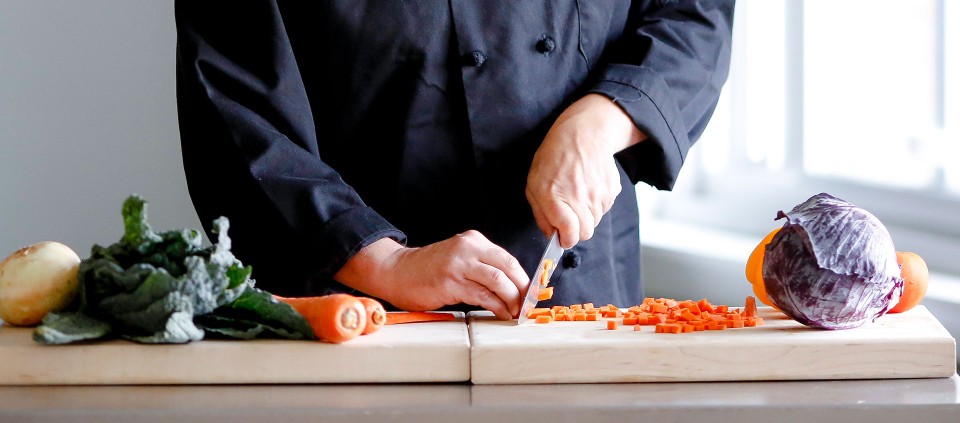The One Knife Everyone Needs, Plus More Chopping Tips from Jeremy Rock Smith

You only need four knives, total.
Never buy sets, because you’ll never use most of the knives. All you really need for chopping is a standard chef’s knife; I love the Santoku. It’s a lightweight knife that originated in Japan, and every manufacturer makes some version of it. You don’t need a high-end one—a $100 knife can last a lifetime.
You’ll also want a serrated knife, something a bit heavier, for slicing bread; a thick-gauge knife for slicing and carving; and a small paring knife.
Test your knife when you’re shopping, to make sure it fits your hand and feels good. A cook’s knife is a carpenter’s hammer or a baseball player’s bat—it’s got to fit you just right and feel like an old friend. There’s a joke in kitchens: Never use another chef’s knife—you’ll end up cutting yourself because you’re just not used to it. One more good rule of thumb: Never catch a falling knife.
There’s a difference between sharpening and honing.
Every time you use your knife, hone it first with a steel bar. Honing isn’t actually sharpening the blade; it’s pushing the edge back into position, which may make it seem sharper, but it's not actually taking any material off the blade. I recommend a diamond steel, which is a touch more abrasive.
When you sharpen a knife, on the other hand, you’re grinding off bits of the blade to create a new, sharper edge. You’ll want to sharpen your knives every few months or less often, depending on how much you use them. The frequency also depends on the season: In the winter, you’ll wear down your knives more because you’re chopping heavy root vegetables versus light greens in the spring and summer. You can watch a YouTube video to learn how, or talk to a butcher—many grocery stores will sharpen your knives for you while you shop.
Cutting boards need tender, loving care.
When it comes to cutting boards, I prefer wood—bamboo is great. Wood is more absorbent, so it won’t dull your knives as much as composite boards do. I keep a separate board for garlic and onions, because no matter how well you wash it, it’s tough to get that taste and smell out. For animal proteins, use a composite or plastic board that won’t absorb the juices.
You can wash your wooden boards with regular dishwashing liquid; if you have a gas stove, leave them in the unlit oven after washing, and the pilot light will be just the right amount of heat to dry the wood without over-drying it. Make sure you oil your boards occasionally with coconut or mineral oil—you’ll know when they need it.
Choose your chop.
There are a whole bunch of ways to cut stuff. Here’s a quick guide:
- Dicing is cutting the food into cubes, for a salad or a chunky soup (don’t bother if it’s just going to be pureed or mashed later). A medium dice is a ½-inch cube, a small dice is a ¼-inch cube, and a large dice is a ¾-inch cube.
- To julienne, cut the food into long, thin rectangular strips, like matchsticks. This is great for stir-fries and salads.
- Chiffonade is the term used for shredding leafy greens and herbs into strips. To chiffonade, stack four or five leaves, roll them up, and slice the roll crosswise.
- Shaving means cutting food paper-thin; you can use a mandoline or spiralizer if you want to get it done faster.
- Cutting on the bias just means cutting on an angle—you’ll often see vegetables like carrots cut on the bias in stir-fries.
Experiment, and remember that you don’t have do it perfectly. You can keep refining your knife work—it’s all about practice, and it’ll taste great no matter what it looks like. Happy chopping!
Sample more videos, recipes, and articles: The Om of Yum
Check out cooking programs with Jeremy Rock Smith at Kripalu.
© Kripalu Center for Yoga & Health. All rights reserved. To request permission to reprint, please email editor@kripalu.org.
Jeremy Rock Smith, Kripalu faculty and a graduate of the Culinary Institute of America, began his career in classical French cuisine.
Full Bio and Programs